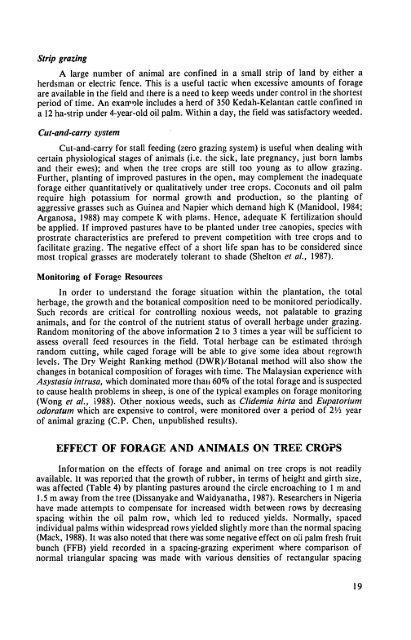Proceedings of a workshop on research methodologies Medan ...
Proceedings of a workshop on research methodologies Medan ...
Proceedings of a workshop on research methodologies Medan ...
You also want an ePaper? Increase the reach of your titles
YUMPU automatically turns print PDFs into web optimized ePapers that Google loves.
Strip grazing<br />
A large number <str<strong>on</strong>g>of</str<strong>on</strong>g> animal are c<strong>on</strong>fined in a small strip <str<strong>on</strong>g>of</str<strong>on</strong>g> land by either a<br />
herdsman or electric fence. This is a useful tactic when excessive amounts <str<strong>on</strong>g>of</str<strong>on</strong>g> forage<br />
are available in the field and there is a need to keep weeds under c<strong>on</strong>trol in the shortest<br />
period <str<strong>on</strong>g>of</str<strong>on</strong>g> time. An exarrole includes a herd <str<strong>on</strong>g>of</str<strong>on</strong>g> 350 Kedah-Kelantan cattle c<strong>on</strong>fined in<br />
a 12 ha-strip under 4-year-old oil palm. Within a day, the field was satisfactory weeded.<br />
Cut-and-carry system<br />
Cut-and-carry for stall feeding (zero grazing system) is useful when dealing with<br />
certain physiological stages <str<strong>on</strong>g>of</str<strong>on</strong>g> animals (i.e. the sick, late pregnancy, just born lambs<br />
and their ewes); and when the tree crops are still too young as to allow grazing.<br />
Further, planting <str<strong>on</strong>g>of</str<strong>on</strong>g> improved pastures in the open, may complement the inadequate<br />
forage either quantitatively or qualitatively under tree crops. Coc<strong>on</strong>uts and oil palm<br />
require high potassium for normal growth and producti<strong>on</strong>, so the planting <str<strong>on</strong>g>of</str<strong>on</strong>g><br />
aggressive grasses such as Guinea and Napier which demand high K (Manidool, 1984;<br />
Arganosa, 1988) may compete K with plains. Hence, adequate K fertilizati<strong>on</strong> should<br />
be applied. If improved pastures have to be planted under tree canopies, species with<br />
prostrate characteristics are prefered to prevent competiti<strong>on</strong> with tree crops and to<br />
facilitate grazing. The negative effect <str<strong>on</strong>g>of</str<strong>on</strong>g> a short life span has to be c<strong>on</strong>sidered since<br />
most tropical grasses are moderately tolerant to shade (Shelt<strong>on</strong> et al., 1987).<br />
M<strong>on</strong>itoring <str<strong>on</strong>g>of</str<strong>on</strong>g> Forage Resources<br />
In order to understand the forage situati<strong>on</strong> within the plantati<strong>on</strong>, the total<br />
herbage, the growth and the botanical compositi<strong>on</strong> need to be m<strong>on</strong>itored periodically.<br />
Such records are critical for c<strong>on</strong>trolling noxious weeds, not palatable to grazing<br />
animals, and for the c<strong>on</strong>trol <str<strong>on</strong>g>of</str<strong>on</strong>g> the nutrient status <str<strong>on</strong>g>of</str<strong>on</strong>g> overall herbage under grazing.<br />
Random m<strong>on</strong>itoring <str<strong>on</strong>g>of</str<strong>on</strong>g> the above informati<strong>on</strong> 2 to 3 times a year will be sufficient to<br />
assess overall feed resources in the field. Total herbage can be estimated thrd'igh<br />
random cutting, while caged forage will be able to give some idea about regrowth<br />
levels. The Dry Weight Ranking method (DWR)/Botanal method will also show the<br />
changes in botanical compositi<strong>on</strong> <str<strong>on</strong>g>of</str<strong>on</strong>g> forages with time. The Malaysian experience with<br />
Asystasiaintrusa, which dominated more than 60%/0 <str<strong>on</strong>g>of</str<strong>on</strong>g> the total forage and is suspected<br />
to cause health problems in sheep, is <strong>on</strong>e <str<strong>on</strong>g>of</str<strong>on</strong>g> the typical examples <strong>on</strong> forage m<strong>on</strong>itoring<br />
(W<strong>on</strong>g et al., i988). Other noxious weeds, such as Clidemia hirta and Eupatorium<br />
odoratum which are expensive to c<strong>on</strong>trol, were m<strong>on</strong>itored over a period <str<strong>on</strong>g>of</str<strong>on</strong>g> 22 year<br />
<str<strong>on</strong>g>of</str<strong>on</strong>g> animal grazing (C.P. Chen, unpublished results).<br />
EFFECT OF FORAGE AND ANIMALS ON TREE CROPS<br />
Informati<strong>on</strong> <strong>on</strong> the effects <str<strong>on</strong>g>of</str<strong>on</strong>g> forage and animal <strong>on</strong> tree crops is not readily<br />
available. Itwas reported that the growth <str<strong>on</strong>g>of</str<strong>on</strong>g> rubber, in terms <str<strong>on</strong>g>of</str<strong>on</strong>g> height and girth size,<br />
was affected (Table 4) by planting pastures around the circle encroaching to 1 m and<br />
1.5 m away from the tree (Dissanyake and Waidyanatha, 1987). Researchers in Nigeria<br />
have made attempts to compensate for increased width between rows by decreasing<br />
spacing within the oil palm row, which led to reduced yields. Normally, spaced<br />
individual palms within widespread rows yielded slightly more than the normal spacing<br />
(Mack, 1988). It was also noted that there was some negative effect <strong>on</strong> oil palm fresh fruit<br />
bunch (FFB) yield recorded in a spacing-grazing experiment where comparis<strong>on</strong> <str<strong>on</strong>g>of</str<strong>on</strong>g><br />
normal triangular spacing was made with various densities <str<strong>on</strong>g>of</str<strong>on</strong>g> rectangular spacing<br />
19

















